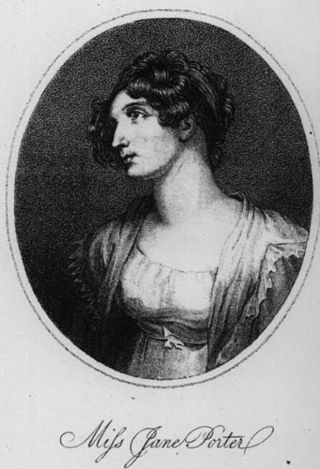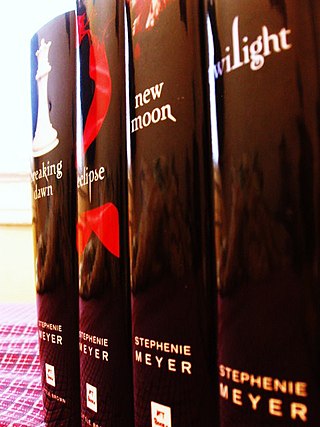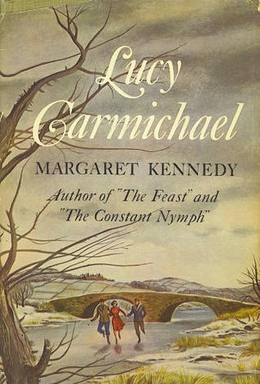
Gothic fiction, sometimes called Gothic horror, is a loose literary aesthetic of fear and haunting. The name refers to Gothic architecture of the European Middle Ages, which was characteristic of the settings of early Gothic novels.

Eroticism is a quality that causes sexual feelings, as well as a philosophical contemplation concerning the aesthetics of sexual desire, sensuality, and romantic love. That quality may be found in any form of artwork, including painting, sculpture, photography, drama, film, music, or literature. It may also be found in advertising. The term may also refer to a state of sexual arousal or anticipation of such – an insistent sexual impulse, desire, or pattern of thoughts.

Genre fiction, also known as formula fiction or popular fiction, is a term used in the book-trade for fictional works written with the intent of fitting into a specific literary genre in order to appeal to readers and fans already familiar with that genre.

Friedrich Heinrich Karl de la Motte, Baron Fouqué ; was a German writer of the Romantic style.

A romance novel or romantic novel is a genre fiction novel that primary focuses on the relationship and romantic love between two people, typically with an emotionally satisfying and optimistic ending. Authors who have contributed to the development of this genre include Samuel Richardson, Jane Austen, and Charlotte Brontë.

Romance films involve romantic love stories recorded in visual media for broadcast in theatres or on television that focus on passion, emotion, and the affectionate romantic involvement of the main characters. Typically their journey through dating, courtship or marriage is featured. These films make the search for romantic love the main plot focus. Occasionally, romance lovers face obstacles such as finances, physical illness, various forms of discrimination, psychological restraints or family resistance. As in all quite strong, deep and close romantic relationships, the tensions of day-to-day life, temptations, and differences in compatibility enter into the plots of romantic films.

Fantasy literature is literature set in an imaginary universe, often but not always without any locations, events, or people from the real world. Magic, the supernatural and magical creatures are common in many of these imaginary worlds. Fantasy literature may be directed at both children and adults.

Nora Roberts is an American author of over 225 romance novels. She writes as J. D. Robb,Jill March and Sarah Hardesty.

Jane Porter was an English historical novelist, dramatist and literary figure. Her bestselling novels, Thaddeus of Warsaw (1803) and The Scottish Chiefs (1810) are seen as among the earliest historical novels in a modern style and among the first to become bestsellers. They were abridged and remained popular among children well into the twentieth century.

Paranormal romance is a subgenre of both romantic fiction and speculative fiction. Paranormal romance focuses on romantic love and includes elements beyond the range of scientific explanation, from the speculative fiction genres of fantasy, science fiction, and horror. Paranormal romance range from traditional romances with a paranormal setting to stories with a science fiction or fantasy-based plot with a romantic subplot included. Romantic relationships between humans and vampires, shapeshifters, ghosts, and other entities of a fantastic or otherworldly nature are common.
Romance Writers of America (RWA) is an American non-profit writers' association founded in 1980. Its mission is to "advance the professional and common business interests of career-focused romance writers through networking and advocacy and by increasing public awareness of the romance genre." Relevant works must be themed around the development of a romantic relationship between two people, and there must be a happy ending. As well as published authors, those with complete but unpublished manuscripts are eligible for membership.
Contemporary romance is a subgenre of contemporary and romance novels. This era of romance novels that were published after 1945 and the Second World War. Contemporary romance is generally set contemporaneously with the time of its writing. The largest of the romance novel subgenres, contemporary romance novels usually reflect the mores of their time. Heroines in the contemporary romances written prior to 1970 usually quit working when they married or had children, while those novels written after 1970 usually have, and keep, a career. As contemporary romance novels have grown to contain more complex plotting and more realistic characters, the line between this subgenre and the genre of women's fiction has blurred.

English literature is literature written in the English language from the English-speaking world. The English language has developed over the course of more than 1,400 years. The earliest forms of English, a set of Anglo-Frisian dialects brought to Great Britain by Anglo-Saxon invaders in the fifth century, are called Old English. Beowulf is the most famous work in Old English, and has achieved national epic status in England, despite being set in Scandinavia. However, following the Norman conquest of England in 1066, the written form of the Anglo-Saxon language became less common. Under the influence of the new aristocracy, French became the standard language of courts, parliament, and polite society. The English spoken after the Normans came is known as Middle English. This form of English lasted until the 1470s, when the Chancery Standard, a London-based form of English, became widespread. Geoffrey Chaucer (1343–1400), author of The Canterbury Tales, was a significant figure in the development of the legitimacy of vernacular Middle English at a time when the dominant literary languages in England were still French and Latin. The invention of the printing press by Johannes Gutenberg in 1439 also helped to standardise the language, as did the King James Bible (1611), and the Great Vowel Shift.

Romanticism in Scotland was an artistic, literary and intellectual movement that developed between the late eighteenth and the early nineteenth centuries. It was part of the wider European Romantic movement, which was partly a reaction against the Age of Enlightenment, emphasising individual, national and emotional responses, moving beyond Renaissance and Classicist models, particularly into nostalgia for the Middle Ages. The concept of a separate national Scottish Romanticism was first articulated by the critics Ian Duncan and Murray Pittock in the Scottish Romanticism in World Literatures Conference held at UC Berkeley in 2006 and in the latter's Scottish and Irish Romanticism (2008), which argued for a national Romanticism based on the concepts of a distinct national public sphere and differentiated inflection of literary genres; the use of Scots language; the creation of a heroic national history through an Ossianic or Scottian 'taxonomy of glory' and the performance of a distinct national self in diaspora.

Romanticism was an artistic, literary, and intellectual movement that originated in Europe toward the end of the 18th century. Scholars regard the publishing of William Wordsworth's and Samuel Coleridge's Lyrical Ballads in 1798 as probably the beginning of the movement in England, and the crowning of Queen Victoria in 1837 as its end. Romanticism arrived in other parts of the English-speaking world later; in the United States, it arrived around 1820.
Elizabeth Rose, 19th Baroness of Kilravock was an eighteenth-century Scottish literary critic and author.
E. M. Foster was a Romantic-era woman novelist. Some 14 popular novels of hers appeared in London between 1795 and 1810.

The type of romance considered here is mainly the genre of novel defined by the novelist Walter Scott as "a fictitious narrative in prose or verse; the interest of which turns upon marvellous and uncommon incidents", in contrast to mainstream novels which realistically depict the state of a society. These works frequently, but not exclusively, take the form of the historical novel. Scott's novels are also frequently described as historical romances, and Northrop Frye suggested "the general principle that most 'historical novels' are romances". Scott describes romance as a "kindred term", and many European languages do not distinguish between romance and novel: "a novel is le roman, der Roman, il romanzo".

Lucy Carmichael is a 1951 romantic drama novel by the British writer Margaret Kennedy. It was her tenth published novel. It was well-received by critics but did not repeat the success of her earlier hits The Constant Nymph and Escape Me Never. It was a Literary Guild choice in America. In 2011 it was reissued by Faber and Faber.

Sophia Fortnum was a British Gothic novelist, and poet.














